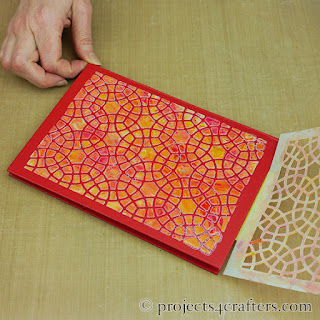Materials needed:
A5 Hard Backed Notebook
Maimeri Iridescent Medium (Premium Art Brands)
Dutch Doobadoo Mosaic Mask
Stampbord Inks
Spatula
Masking Tape
Step 1. Take your notebook and make sure the cover is clean.
Step 2. Position the mask on the front of the notebook and secure in place with some masking tape.
Step 3. Cover the mask with Maimeri Iridescent Medium.
Step 4. Add drops of Stampbord Inks over the top of the medium.
Top Tip: The more medium you have on the mask the more you will have to work the inks into it before scraping off the excess. This will generally mean that the colours are lighter and blended more.
Step 6. Add more ink for a stronger coloured finish if desired. (Alternatively, scrape off the worst of the excess medium before applying the inks.)
For more contrast between the colours don't overwork the medium with the spatula to stop them mixing too much.
Step 7. Carefully remove the mask and leave to dry. If any of the medium has leaked under the mask you can clean it up with a damp cottonbud.
It doesn't take long to become touch dry as it is only a thin layer of medium, but all acrylic paints and mediums need to be left of approximately a week to thoroughly dry and allow the paint/medium to cure.
Happy crafting!






























